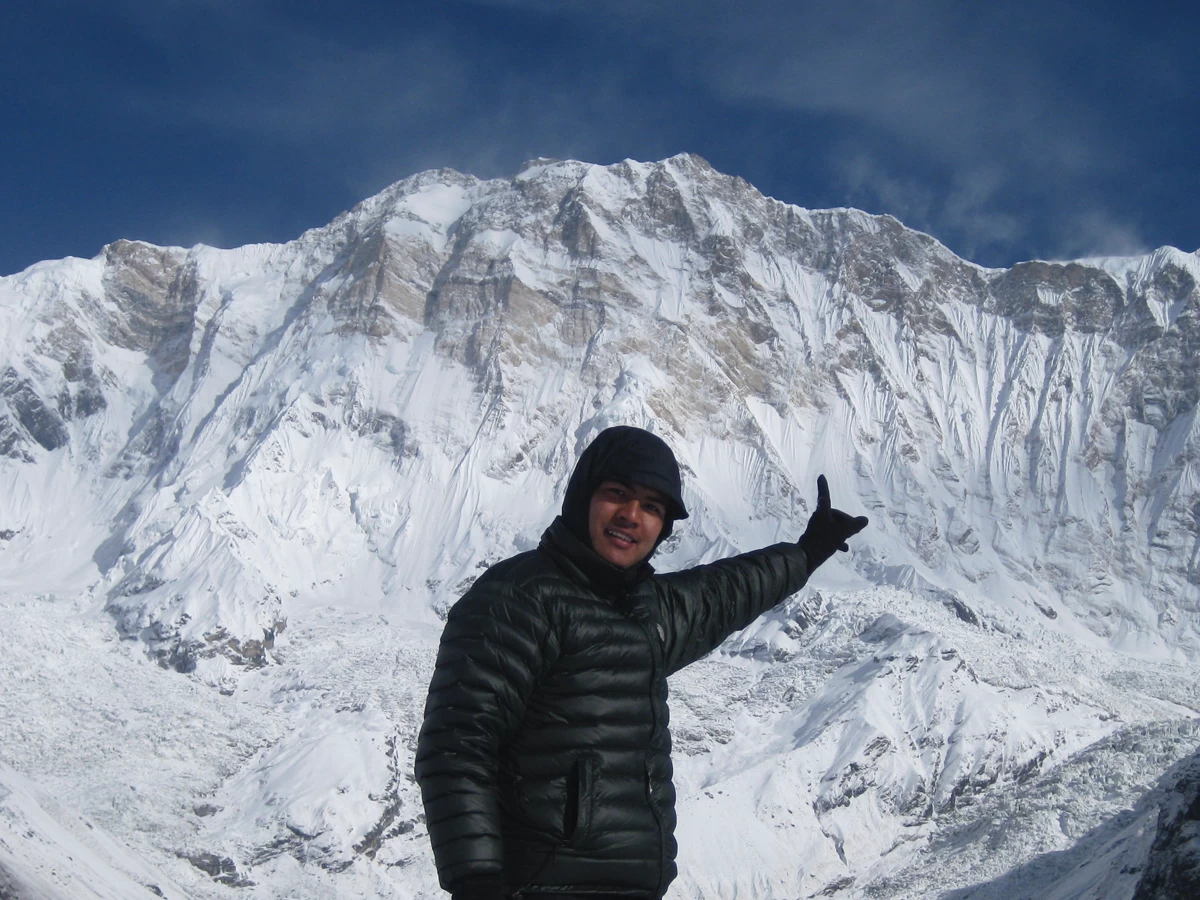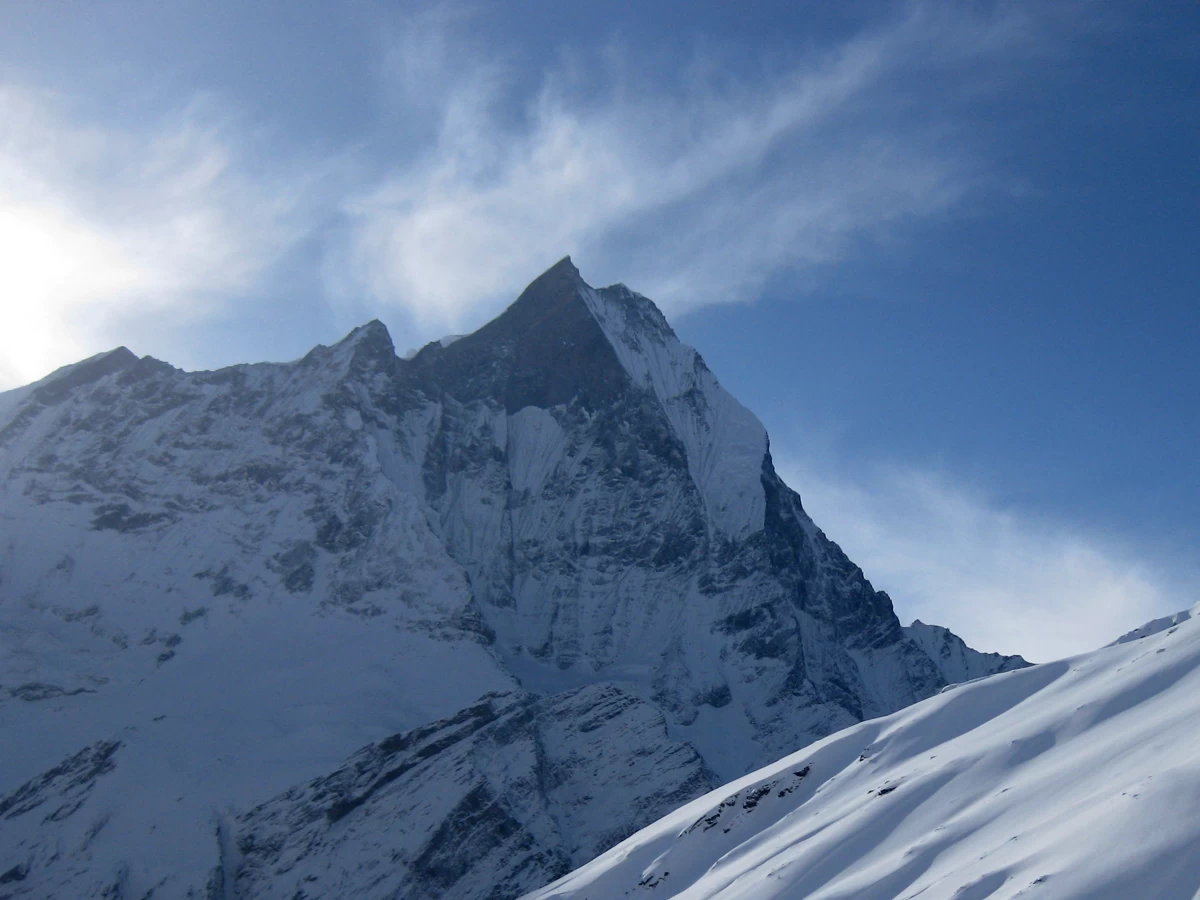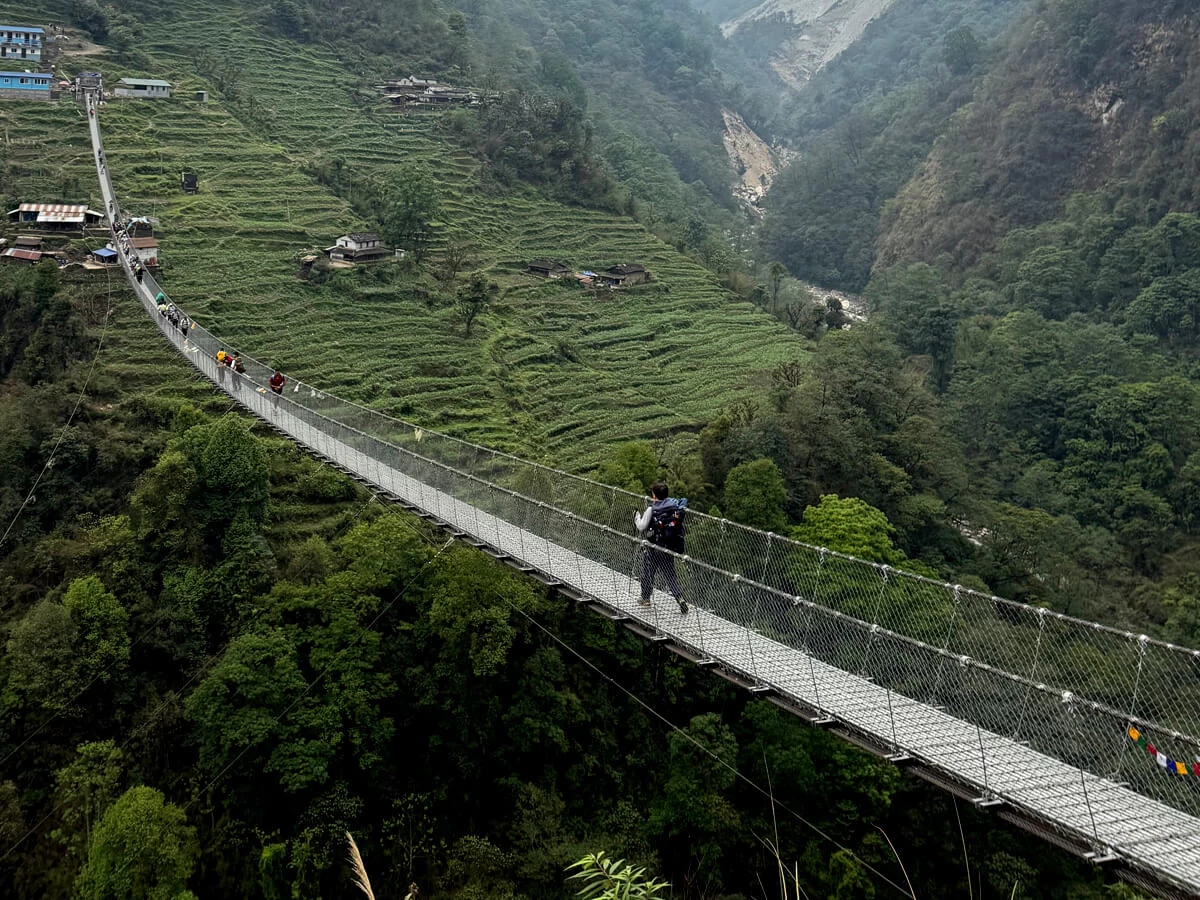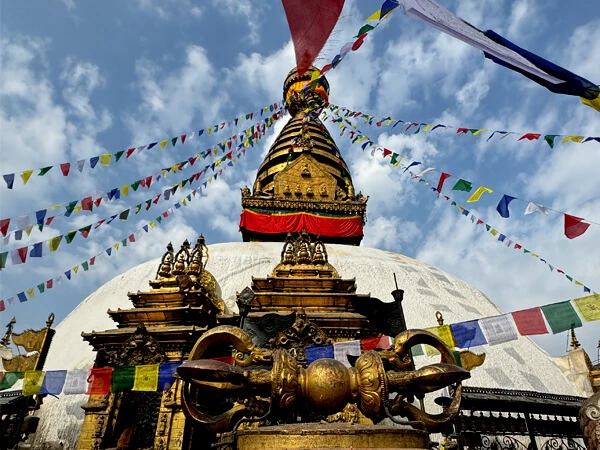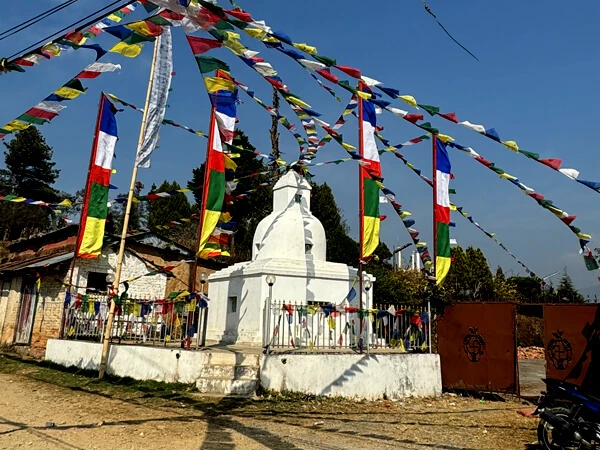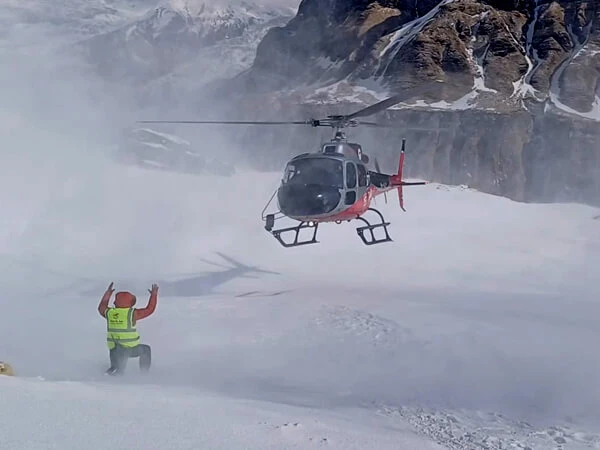The 13 days Annapurna Base Camp Trek is a one of Nepal's most popular trek which includes breathtaking view of mountains like Annapurna 1, Machhapuchhre (Fish tail), Gangapurna and many more. The trek offers not only physical adventure but This Trek offers both peace and adventure like hot springs at Jhinu Danda, stunning sunrise view from Poon Hill and warm cultural interactions from Magar and Gurung communities.
Annapurna Base Camp Trek Via Poon Hill
Trip Facts
The 13-day Annapurna base camp trek does not require any introduction or description. The beauty of Annapurna base camp has been well spoken of by the visitors it has welcomed. Annapurna Base Camp is also termed ABC Trek, Everest Base Camp, and Trekking to Annapurna Base Camp in Nepal, the most desirable destination for adventure enthusiasts. Mount Annapurna is also listed as one of the top 10 highest mountains in the world, adding more value to Annapurna Base Camp and its inexpressible natural beauty.
Beyond ethnic culture and wild green high hills, in between the ever-flowing Modi River, we land at the base camp of Annapurna, surrounded by Mount Annapurna's range along with Machhapuchre, Gangapurnna, Himchuli, and a peak. Hiking trails are not just decorated with unique flora and fauna and a fearless river, but also accompanied by heart-pleasing scenes of mountains in all directions. Annapurna Base Camp not only gives relief to your body but also to your heart and soul.
13 days Annapurna base camp trek via Poon Hill, where trekkers go through the pinkish and reddish rhododendron forests that furnish the entire trail for visitors. Besides, the diversity of flora and fauna can be encountered, which lights up the journey to Annapurna Base Camp. Fearless following the Modi River continuously encourages climbing up and cherishing the incredible creation of nature. Your mountain view from Poonhill is much closer to Annapurna Base Camp. On the way to ABC, the Machhapuchre base camp shows the magnificent beauty of Machhapuchre and Annapurna, and drives you further to accomplish your destination at Annapurna Base Camp.
ABC Trek offers a close-up view of wide mountain ranges, creating a dilemma of which direction to watch. Nepal Adventure Team polishes its experience and knowledge in the field of trekking and enables the trekkers to trek to their desired destination most desirably. Undoubtedly, the Annapurna base camp holds the charisma to uplift nature’s beauty, which each visitor praises, and this trek would be more worthwhile with the Nepal Adventure Team. Grab the best offer package with an early booking for 2025 and 2026
Best Time to Trek To Annapurna Base Camp
The optimum season to trek to and from the Annapurna Base Camp is spring and/or autumn. These are the best times to trek since they come with sound, predictable weather, and intense sunlight, but they are not too hot and are suitable for trekking. Wildflowers bloom along the trail during spring, and beautifully-colored rhododendrons during summer, while autumn exhibits clear visibility of snow-clad peaks. Both seasons provide good trekking weather, avoiding the possibility of monsoon rain during the winter months or the harsh cold of winter. Expect crowded trails, the ability to meet other like-minded trekkers, and a lot of opportunities to be enchanted by the beauty of the mountains.
Challenges and Tips During the Annapurna Base Camp Trek
Trekking to Annapurna Base Camp presents several challenges that trekkers should be prepared for, along with some valuable tips to enhance the experience. Trekking to Annapurna Base Camp presents several challenges that trekkers should be prepared for, along with some valuable tips to enhance the experience:
Altitude: Looking at potential difficulties, I can name one of the first significant problems – acclimatization with altitude increase. It is important to note that altitude sickness is not a disease of the weak or unfit since it can affect anyone involved in outdoor activities. One should always take time to acclimatize, ascend steadily, drink plenty of water, and look out for signs of altitude sickness, which include headache, nausea, or dizziness. The party must reach a lower elevation if the symptoms do not dissipate.
Weather: Although the best times for trekking are March, April, and May, the hills of the Himalayas can be very fickle weather-wise. There is a possibility of encountering a wet spell, cold weather, or a storm on the mountain. Choose versatile clothing outfits that can be augmented or diminished depending on the change in weather. Also, please ensure your rain jacket is strong enough and has waterproof hiking boots. Also, wear clothes that take a little time to dry.
Trail Conditions: ABC is quite strenuous, with sharp climbs, steep rocks, and rugged and sometimes slippery terrain. Because the terrain is extremely rough, good trekking shoes with ankle support are important. Trekking poles can also add balance and lessen the impact on your knees during the descent.
Physical Fitness: Given its nature and the altitude of the Annapurna Base Camp, this trek is not for the faint-hearted. It comprises several hours of walking daily and may span many days. If one has to plan on trekking, one should incorporate physical and heart-rate-engaging exercises before trekking. To complete the trek without exhaustion, you can continue upwards and regulate your pace, which should not be very hectic.
Hydration and Nutrition: Drink lots of water to prevent dehydration, which may be familiar at a higher altitude. Drinking several glasses of water at different times throughout the day or carrying a water bottle is recommended. Always pack water purification tablets or a portable water filtration system if you need to refill your bottles locally. Could you make a point of always having your meals balanced to have enough energy once the treks start?
Accommodation and Facilities: Lodging is available from a relatively rudimentary tea house to a comfortable lodge, hotel, or guest house. It is worth taking a bed during high seasons, without which getting one from the various featured hotels would be very hard. There could be limited access to necessities like electricity for lighting and hot water for showers, or they may be limited to some charge. Take an extra battery charger for your electronic gadgetry and a portable lamp or flashlight, especially when moving around in the evening.
Permits and Documentation: Could you check and recheck that you have acquired all the required permits (TIMS card, ACAP permit, etc)? Keep spare copies of your passport and insurance documents in a waterproof holder. Ensure these documents are relatively easy to see for the checkpoint inspection along the trekking route.
To maximise your adventure, take the best shots and enjoy the cultural sites in Nepal. Given the natural beauty of the Annapurna Base Camp, it's crucial to prepare adequately. Understand and respect the challenges involved before and during the hike, and then consider implementing these tips.
Altitude Sickness and Acclimatization
Mountain sickness or acute mountain sickness (AMS) is an ailment that affects trekkers and climbers when they ascend to high altitudes without allowing the acclimatization of the body. It usually happens at altitudes of more than 2,500 meters or 8,000 feet and becomes more frequent the higher you go. Altitude sickness's possible manifestations may be as mild as mild headaches, nausea, dizziness, fatigue, shortness of breath, or severe, such as difficulty sleeping.
Another important concept that occurs in high-altitude locations is known as acclimatization. Acclimatization involves changes in the human body when it adjusts to the low oxygen levels available in the elevated regions. It also entails physical changes like an increase in the rate of breathing and heartbeat, and the number of red blood-containing cells. Acclimatization should be given a lot of importance during the trekking experience.
Here are key tips for managing altitude sickness and effectively acclimatizing during the Annapurna Base Camp trek.
Climb up step by step and wait for the endurance to build up for the higher ground. The guideline used in mountain climbing is "climb high and sleep low"—the rule means that during the day, one has to ascend to a higher altitude, but at night, one sleeps at a lower altitude.
Consume a lot of fluids during the day, as dehydration worsens the symptoms of altitude sickness. Eliminate alcohol and caffeine, which have diuretic effects and make the human body lose more water.
For alpine area climbing, it is recommended that more rest days be planned to allow for adequate acclimatization. These days consist of moderate strenuous activity, ascending to higher altitudes, and sleeping at a lower altitude. Focus on these days, let go a little, drink plenty of water, and let your body gradually get used to the change.
Please be aware of the first signs of altitude sickness and inform any trekking guide or other team members about any worsening of your condition. Appropriately identifying the disease in its preliminary stages can help avert its aggravation.
Taking medicines such as acetazolamide (Diamox) is recommended to avoid the effects of altitude illness. Nevertheless, one must understand that medication cannot replace the client's proper acclimatization and must be used with a doctor's consultation. Take plenty of carbohydrates, proteins, and fats because you will need energy to trek and adjust to the altitude.
If there are signs of altitude sickness, and despite taking self-prescriptions, one should go lower in altitude. Descending is the simplified and most efficient therapy for altitude sickness, which can quickly lessen the manifestations of the disease.
Altitude sickness can also occur regardless of fitness level. Even if the victim has not experienced altitude sickness in previous treks, pay attention to the signs shown by their bodies. Be as safe as possible during the hike by following the proper principles of correct acclimatization.
Safety Tips and Common Hazards
Knowing these usual risks and precautions will make trekking to Annapurna Base Camp safer and more productive. Thus, one can explore the incredible scenery and colorful culture of the great Himalayan realm.
Weather Preparedness: There are sudden changes in climate in the Himalayas, as it can be sunny at one time and blizzardy at the other. Good advice is to always check for favorable weather conditions before going on the trek. Maintain a proper dress code, having many clothes on them with a waterproof coat and warm clothes. Your equipment must withstand the rain or snow or be well covered by rain or snow protective covers.
Altitude Management: It is essential because diseases such as altitude sickness can be prevented only if man gradually adapts to height. Acclimatize, which means climbing up gradually so your body can acclimate to high altitude. Always ensure you drink loads of water and avoid drinking alcohol, and if you feel that your body needs to rest, do not undertake a workout for the day. Pain, ringing in the ears, headaches, nausea, and dizziness are early signs of altitude sickness, and you should descend if the symptoms remain or aggravate.
Trail Safety: The gross route to Annapurna Base Camp is challenging as it integrates steep climbs and steep, rough terrain, and in some places, one is likely to encounter slippery floors. Also, it is recommended to put on firmly fitted, robust shoes specifically designed for hiking with adequate support for the ankle. Trekking poles should enhance balance, emphasizing going down the slopes. As for the tricky parts, I ask that you please do not stay away from your group and listen to your guide.
Hydration and Nutrition: Drink plenty of water throughout the day to ensure adequate body water. Many hikers run out of water before reaching their destination, so pack water purification tablets or a water filter for augmentation. Adequate meals containing carbohydrates, proteins, and fats should be consumed during those days, as it can be tiring to trek all day.
Emergency Preparedness: Always have a charged and available mobile phone, and if you're going even further off the beaten path, you could invest in a satellite phone or PLB. You must have a list of emergency contacts, including local authorities and the trekking agency you are affiliated with. Could you share the medical facility contacts available and learn the procedures to be followed in incidents like fires?
Group Safety: Hiking with a professional guide is safer since they know the area's geography and can help, especially when caught in tricky circumstances. You should follow your group guide's instructions strictly in the more strenuous terrains that call for crossing a river or steep streets. Do not hike alone, especially in areas not well known to the people.
Environmental Awareness: Adhere to the location's natural resources and people's culture by following the "Tread Lightly Policy." Take all MW and discharge it well at the appropriate locations for disposal of non-biodegradable waste. Do not trespass or engage in any activities that will negatively affect wildlife and any natural resources that might be available.
Accommodations and Amenities during ABC Trek
Tea Houses / Lodges:
Staying options within the ABC Trek area include tea houses, providing lodging to trekkers, and providing them with a close-knit and social environment. Simple hotel-like rooms and twin or dormitory accommodations with shared baths generally characterized these tea houses. The rooms are basic but neat and dry; sometimes, the rooms would be empty, provided with only blankets or a basic bed. This is uncommon, but some tea houses offer charging points for devices and/or hot shower facilities that are chargeable extra. Food at tea houses is freshly prepared and eaten in dining halls. Open to all the trekkers, where different foods are available, be it the local Nepali dish, dal bhat, or other types of noodles, soups, tea, or coffee. Tea houses are cozy and comfortable, so trekkers usually rest in these places after a long day's hike in the beautiful scenery of the Himalayas.
Guest Houses / Inns:
Places such as larger villages within the area of the ABC Trek offer guest houses or inns, which are a little better in terms of comfort than tea houses. Guesthouses tend to be more comfortable with ALOs with attached toilets and more enclosed than hostels. The Internet might be one of the amenities, but the connection quality can be standard or even poor. Guest house meals are also like those at tea houses, with bills containing a list of available local and international meals one can order. The trekkers will get a much warmer response from them and will be able to communicate with the other trekkers and the local people of Nepal. Thus making their trek more culturally rewarding.
Camping:
Another option for trekkers who want to hire an adventurous outdoor experience is to stay in tents at different campsites throughout the ABC Trek, particularly in areas with no existing facilities. Tent pitching or camping is where people can take a Macedonia where they erect small tents at campsites and have self-contained treks. The one aspiring to go camping should provide their camping equipment, such as a tent and a sleeping bag capable of accommodating cold weather, among other things, and more so if the client is bringing their food. On the other hand, trekking agencies also have camping arrangements. They provide all the required items like tents and human resources to make camping a delightful moment. There is an element of freedom regarding the plan when camping on the ABC Trek and embracing the opportunity to spend a night in a tent under the cover of stars and the sky with the almighty Himalayas in the background.
Food During the ABC Trek
Dal Bhat: Local rice, Dal Bhat Tarkari, a lentil soup accompanied by rice and vegetables, is ubiquitous and preferred because it is energy-intensive.
Noodles and pasta are often served as toppings in chow mein and spaghetti; they can also be accompanied by vegetables or meat. Soups and Stews: Some choices are vegetable soup, chicken soup, and Thukpa, a noodle soup good for body warmth and energy. Local Specialties: Some unique local food products are momos, i.e., dumplings, yak cheese, and Tibetan bread, available in some villages.Western and International Cuisine: They are found in the bigger guest houses and offer sandwiches, pancakes, pizzas, and burgers, among others.
Highlights
- Tour numerous ethnic groups, such as the Gurungs and Magars, and enjoy their warm, flavorful hospitality and way of life.
- For those mesmerised by tired muscles, explore the natural hot spring water at Jhinu Danda, which is blessed with greenery and river sights.
- You will cross through the beautiful Modi Khola Valley to reach the circular structure of the Annapurna Base Camp.
- Get breathtaking views of Annapurna I, Machhapuchhre (Fishtail), and Hiunchuli, all blanketed in snow.
- Cross various terrains, from sub-alpine Rhododendron forests to alpine meadow land, billion tree projects, and many more.
- Tourism at places like the villages of Ghorepani and Chhomrong provides a glimpse into the traditional way of life in the mountains.
- At times, there are beautiful tea houses for the trekkers with nice hospitality, local meals, and great views of the mountains along the way.
- Enjoy the spectacular view of the sun rising and setting on the Himalayan peaks, which spreads a nice golden and pink blanket.
- Annapurna Base Camp, at 4130m, is the destination, and it is satisfying to reach this place in the shadow of the mighty Himalayas.
Outline Itinerary
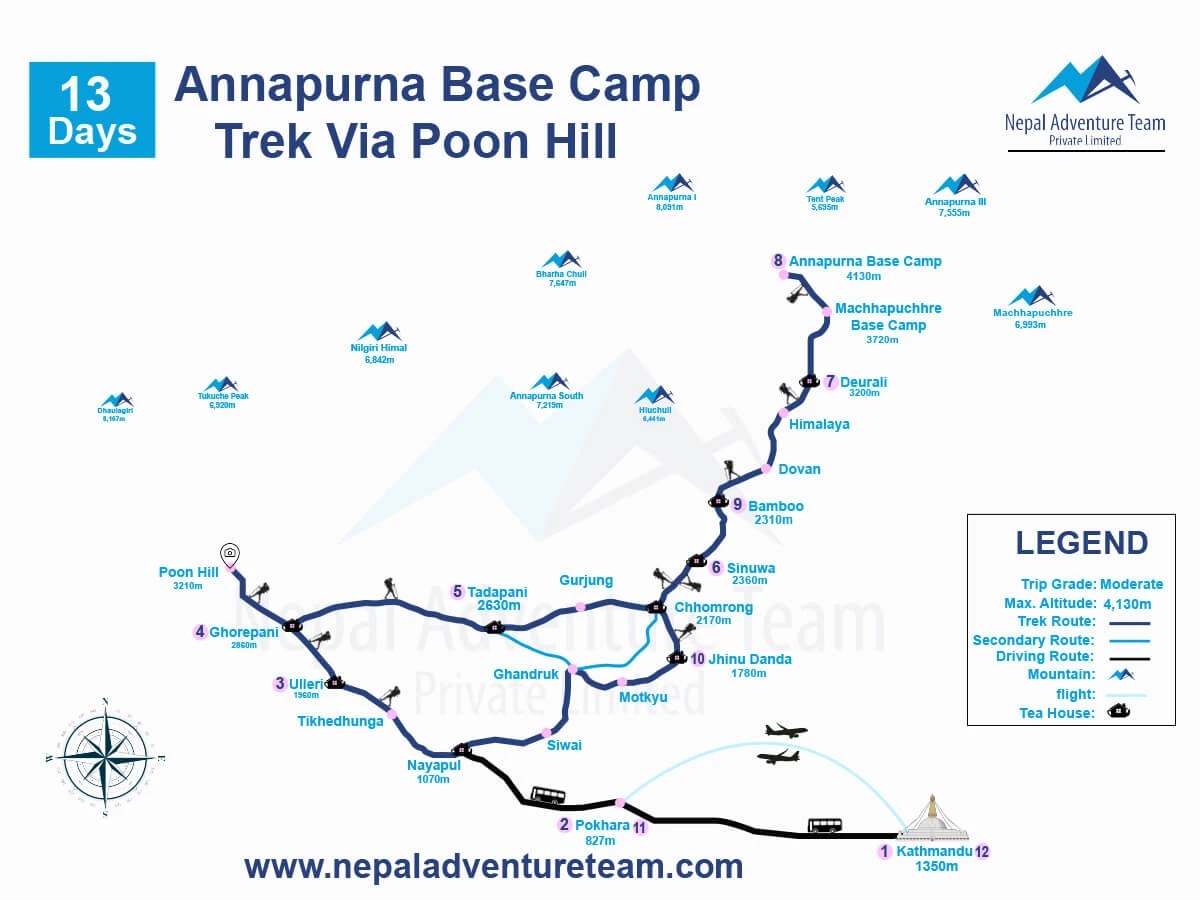
Annapurna Base Camp Trek Via Poon Hill Itinerary
Arrival in Kathmandu 1350m
Nepal Adventure Team’s staff and guide receive you at Tribhuvan International Airport and transfer to the respective hotels in Thamel, tourist hub of Kathmandu. After refreshment, our guide / leader brief you regarding hotels, Nepali cultures, tours and Annapurna Base Camp Trekking along with welcome dinner in a typical Nepalese restaurant assisted by a folk cultural program.
Drive to Pokhara 860m (220 km) - 06 hours
We drive for about 06 hours to popular tourist city Prithvi highway. The drive carries you through the local market, local lifestyle, Trishuli river, Marsyangdi river, hills, woods and view of mountains: Annapurna, Manaslu, Dhaulagiri and Machhapuchhre (Fishtail). You be transferred to a hotel. You can rest or chill nearby Phewa lake as well as enjoy the night life.
Drive to Nayapul and trek to Ulleri village(1960 m)-05 hours
An hour early drive to Nayapul from Pokhara, begins the trek towards Ulleri. Short walk uphill leads to Birethati (1015 m). Tikhedhunga is our lunch spot for the day. Passing through traditional houses, shops and Magar settlements, the tough steep steps land us to Ulleri for the overnight stop. Ulleri is widely known for steep slope of hill.
Trek to Ghorepani 2,840 m - 05 hours
Annapurna South and Mt. Machhapuchhre welcome trekkers to Annapurna region as we head beyond Ulleri. The walk gets better on the winding path through green alpine tree-lines of oaks, pines and rhododendron and chilly fresh breeze blowing all around. You gain more height of views at Ghorepani-Deurali village as it is accesssorized by scenery of world’s 7th highest Mt. Dhaulagiri and its range of peaks as well as Annapurna South and Vara-Shikar. Ghorepani is located in the midst of old Trans-Himalayan Salt Trade Route which stretches all the way to Upper Mustang unto Tibet and since decades used as a resting point. Additionally, people usually stay to enjoy the hike to Poon Hill, a view point offering super wide angle views of world’s three highest peaks and other mountains with striking sunrise and sunset.
Morning hike to Poon-Hill and stay at Tadapani 2,520m - 05 hours
Here, morning starts before the sun as we hike up to Poon-Hill at 3,210m to be mesmerized by fantastic sunrise over the mountain range from Mt. Dhaulagiri, Mt. Manaslu, Mt. Machhapuchhre to Annapurna and as far to Ganesh Himal in the far eastern horizon. With the shimmering beginning of morning, walk continues uphill and downhill passing small places of Deurali and Banthati to settela at Tadapani for night. Tadapani is located in the middle of enchanting woods with super views of Annapurna and Machhapuchhre.
Trek to Sinuwa 2340 m-5 hours
We head for Chomrong village where we have lunch with the chilly surrounding and views of hills, rivers, trails and mountains. Reenergize through lunch, we descend to cross suspension bridge joining to Sinuwa. As we plan to saty at Upper Sinuwa, we climb up hill passing by the lower Sinuwa. The walk could be a bit strenuous this day comparing to the other day but the friendliness of locals and the sharing smiles with other trekkers makes you forget tough steps.
Trek to Deurali 3230 m - 5 hours
From Sinuwa, we move through cool thick forest until Bamboo is reached, located by the Modi River in the middle of bamboo, rhododendron and oaks forest. Further, for lunch we target to reach Dovhan. We encounter small Hinko cave too which give the clear sight of Deurali village. Deurali is the night stop where few hotels are available and has quite cold weather which gives the feel that we are not far from our ultimate destination Annapurna Base camp.
Trek to Annapurna Base Camp 4, 130m - 04 hours
As we march forward from Deurali, we walk by Modi River as if we are aiming to reach the origin of Modi and we do so too. Continue steep climb drop us to Machhapuchre Base Camp. Machhapuchre is the virgin mountain as it has never been climbed up due to its peculiar shape. As we reach MBC, our eyes strikes with Annapurna ahead backed up by the view of Machhapuchre.
Then, the moderate climb and walk lands us to our ultimate fascinating destination Annapurna Base Camp. Annapurna Base Camp gives stunning views of Annapurna and the Dhaulagiri Ranges that include Mt. Annapurna I (8091 m), Mt. Dhaulagiri (8167 m), Mt. Manaslu (8163 m), Mt. Annapurna II (7937 m.), Mt. Annapurna III (7555 m), Mt. Annapurna IV (7525 m), Mt. Annapurna south (7219 m), Mt. Nilgiri (7041m), Mt. Fishtail also called Mt. Machhapuchhare (6998 m), and Tilicho peak (7134m) at the closest which encircles the sanctuary. Annapurna area was first explored by British Adventurer Col. James O.M. 'Jimmy' Roberts in the year 1956 and exposed to the world as the 'Sanctuary of Gods'. The Sanctuary is also popular as "Annapurna Sanctuary" ever since.
Trek to Bamboo 2,050 m - 06 hours
Accompanied by heart pleasing surrounding of Annapurna Base Camp trails, we gradually march to reach Bamboo for the night stay. As we are moving on the same path, we walk through Deurali, Hinko Cave and Dovhan to rest in-between of Bamboo forest named as Bamboo
Trek to Jhinu-Danda 1,700m via Chomrong - 05 hours
As we had on early route, we have lunch on Chomrong by passing the Sinuwa village. From Chomrong, our route to Pokhara changes from the route we had reached to Annapurna Base Camp. We reach to Chomrong ridge which gives insights of trails we walked and have to walk, Himalayas, Modi river and settlement on hills. Through the steep downhill steps, we settle to Jhunu-dada for warm night stay. Jhinu offers refreshing hot springs just 20 minutes from Jhuni- dada walk by the bank of Modi river.
Trek to Nayapul and drive to Pokhara -6 hours
Since we are heading towards Nayapul from high uphill, mostly require to descend the hills. Initially, we walk down from Jhinu dada and cross the suspension bridge above Modi river. Our trail follows the Modi river. The villages as Saulibazar and Birethanti are encountered on the way to Nayapul. An hour drive from Nayapul drops us to Pokhara valley with touch of nature on modern facilities
Drive back to Kathmandu
Early morning drive on Prithivi highway return us to Kathmandu. You can just relax after trek or browse around the market as well as observe night life. Besides, if required you can ask your guide to explore around. Farewill dinner is also organized.
Final departure day
With the big heart after visiting Annapurna Base Camp, as per your schedule, Nepal Adventure Team drops you to Tribhuvan International Airport. Nepal Adventure Team is open to your feedback and reviews as well as bid you goodbyes with the hope to meet you soon in your next trip in Nepal.
Annapurna Base Camp Trek Via Poon Hill Cost Details
Includes
- Airport pick up and drop off by private jeep/car
- 2-night (3 stars) hotel in Kathmandu and Pokhara on a BB plan, twin-sharing basis
- Welcome and farewell dinner at a typical Nepali restaurant with a cultural program
- Kathmandu - Pokhara – Kathmandu both ways by deluxe tourist bus
- Pokhara – Nayapul - Pokhara both ways by car
- 8 nights’ teahouse accommodation throughout the trek
- Full board meals: breakfast, lunch, dinner, and tea/coffee in a cup during the trek
- Seasonal fruits and salads daily
- ACAP permit (Annapurna Conservation Area Project)
- TIMS Card (Trekkers Information Management System)
- An experienced English-speaking trekking guide and his expenses, insurance
- A porter for two trekkers and his expenses, insurance
- Sleeping bag, down jacket, and duffel bag (provided if required, but to be returned after)
- First Aid medical Kitbag
- Certificate of appreciation after completion of the Annapurna Base Camp Trek
- Nepal Adventure Team (NAT) T-shirt
- Government VAT and Local Taxes
Excludes
- Nepal visa fee and international flight
- Sightseeing in Kathmandu and Pokhara
- Personal expenses
- Extra accommodation and meals behind schedule
- Travel and rescue insurance
- Gratitude to the staff
Dates & Availability
The following are the fixed departure dates and a typical schedule. ABC Trek booking is open for 2026. We can arrange a unique and private package for you.
Essential Information
Permits and Documentation Required
TIMS Card (Trekkers' Information Management System)
It is mandatory to possess a TIMS Card when you are trekking to the Annapurna area, regardless of whether your trek takes you through Poon Hill or otherwise. It helps in handling trekker information and in the protection of those creating treks. The card gives essential information to authorities about trekkers and details that assist in tracking movements during the trek. It improves security and allows for rescue if needed because it is less complex and time-consuming. As for the TIMS Card (Trekkers’ Information Management System), one can get the card for the ABC (Annapurna Base Camp) trek via Poon Hill at the NTB offices in Kathmandu and Pokhara. The office is established at Pradarshani Marg in Kathmandu and Damside in Pokhara. Furthermore, the original and legally issued Trekking agencies can also help obtain a TIMS Card. You need to provide a passport-size photograph and your passport when you apply for it.
ACAP Permit (Annapurna Conservation Area Permit)
The permit is the ACAP Permit, which is required to enter the Annapurna Conservation Area under the National Trust for Nature Conservation (NTNC). This permit is issued to preserve the natural environment, control the tourist flows, and increase the area's scholarly population. The measures in place guarantee responsible trekking and support the development of local communities by generating income from tourism. Currently, there are three ways for trekkers to obtain the ACAP Permit: They can get it directly from NTNC's head office in Kathmandu, its regional office in Pokhara, or through licensed trekking companies.
Local Area Permit (if applicable)
Additional permits are available locally, depending on which route you choose for the trek. These permits are usually available at checkpoints along the path or the trekking trail. These regulate the conduct of trekkers and guide them through particular areas or several villages in the Annapurna region. Some restricted areas may require special permits, which your trekking agency or the guide will help you get during the trek as and when necessary.
Passport Copies
When applying for the TIMS Card and ACAP Permit for the trek, trekkers must attach a copy of their passports. It is ideal to bring two copies of your passport: the main page with the biographical details and the page on which the visa is placed. These copies are enclosed in the permit applications so that the authority can determine the applicant's identity and nationality. It is recommended that the original passport be safely at hand throughout the trek in case of any brief identification processes.
Entry Permits for National Parks and Conservation Areas:
Depending on the actual trekking route covering the Annapurna region and specific areas, additional permits, such as a National Park/ Conservation entry permit, may be necessary. These permits are required to meet the legal requirements of the regions enforcing protected areas and commendable approaches to tourism. Depending on your trekking agency or guide, additional licenses may be required based on the specific planned route. You'll need two permits and two compulsory documents in the Nepalese territory: the Annapurna Conservation Area Permit (ACAP) and the Trekkers’ Information Management System (TIMS) card. You should also bring your passport photos and your actual passport for the application. These permits are required to trek in the Annapurna region to assist in the preservation and safety of trekkers.
These permits and documents needed for legal trekking in the Annapurna region benefit the trekking industry and the environment by improving the area's stewardship, safety, and management. Trekkers should check with the relevant authorities or agents dealing with the trekking business to see if the permits have been changed or the conditions have been modified.
Passport and Visa Requirements
Foreign nationals, except Indian citizens, must obtain a visa to enter Nepal. This can be done at the Nepalese Embassy or consulate in your country or upon arrival at Kathmandu International Airport. You'll need two passport-sized photos, visa fees, and a valid passport to apply.
Tourist Visa Fees:
3-day transit visa: Free
15 days: USD 30
30 days: USD 50
90 days: USD 125
For more details, contact the Department of Immigration:
Location: Kalikasthan, Kathmandu
Transportation
Tourists can travel by bus, private vehicle, or on foot. Unless stated otherwise, all transportation costs are included.
Travel Insurance
It's essential to have travel insurance before traveling abroad. Please ensure you have your insurance documents, as Nepalese insurance companies do not cover foreign nationals. Insurance should cover rescue, medical assistance, and lost or stolen belongings.
Solo Travelers
Solo travelers will only pay for a single trip but must share accommodation with others of the same gender. They can also join other groups.
Health and Fitness
This moderate trek requires no previous experience, but participants should be physically and mentally healthy. Preparing with regular jogging and running is recommended. Those with pre-existing medical conditions should let us know beforehand.
First Aid and High Altitude Sickness
A personal first aid kit is strongly recommended. The trek involves high altitudes, but slow walks and regular stops help acclimatize and prevent Acute Mountain Sickness (AMS), which can be fatal if not properly managed.
Guides and Porters
Our guides are trained, experienced, and licensed to ensure a safe and enjoyable trek. Porters are well-equipped and insured, carrying up to 25kg each. They are well compensated and treated with respect.
Best Time to Travel
The ideal times for trekking to Annapurna Base Camp are Spring (March to May) and Autumn (September to November) due to favorable weather and clear views. Winter is manageable, but the monsoon season is less popular due to heavy rains and challenging roads.
Equipment and Packing List
Upon booking with the Nepal Adventure Team, pack the following essentials:
- Travel documents: passport, visa, travel insurance, air tickets, voucher, and passport photos (x2)
- Bank cards, credit cards, and travelers' cheques
- Comfortable boots and sports shoes
- 6-8 pairs of woolen/cotton socks
- Fleece jacket, down/duvet jacket, rain/windproof jacket
- Two pairs of gloves
- 4-6 t-shirts and woolen/cotton shirts
- Day cap and woolen hat/balaclava
- Trousers, shorts, and tracksuits
- Four-season sleeping bag with inner liner
- Large and small towels
- Toiletries
- Water bottle
- Sun/snow glasses
- Optional ski/walking poles
- Personal first aid/medical kit
- Rucksack/backpack
- Duffel bags (carried by porters or animals)
- Torch/flashlight with spare batteries
- Pen knife/Swiss knife
- Scarf/mask (for dust and wind)
- Personal hygiene items
- Extras like binoculars, cameras, books, and journals
Precautionary Note
The trekking itineraries are designed to be manageable and enjoyable. Do not rush, and follow the guide's pace. Conditions may be challenging, but you will adapt.
Trip Safety
Your guidance will ensure the safety and security of your valuables. For important documents and money, use a wallet or belt, and secure your luggage in the hotel's safety deposit box.
Important Rules
Illegal drugs are strictly prohibited. Respect local laws, customs, and beliefs to avoid group expulsion.
Responsible Tourism
We believe in responsible tourism and respecting local people and the environment. Clients should:
- Respect local laws and customs
- Seek permission before engaging in local activities
- Keep areas clean and dispose of rubbish properly
- Support local skills and positive aspects of tourism
Feedback and Reviews
We value your feedback. To that end, we're offering an 8% discount on your next trip for completing an online review or feedback.
Additional Information
For more details, contact us or contact Mr. Jeevan Thapa Magar at +977 9851234322 (Viber/WhatsApp).
Annapurna Base Camp Trek Via Poon Hill FAQs
The Annapurna Base Camp trek is located in the Annapurna sanctuary, which is north of the tourist attraction, Pokhara City. The Annapurna Base Camp trekking route takes you to the north-central region of Nepal in the Gandaki zone. Kali Gandaki borders it on the west while Marsyangdi River is on the north. It begins from Nayapul and heads to the center of the Annapurna Conservation Area.
The major highlights of the Annapurna Base Camp trek are listed below:
- Get introduced to the Gurung, Magar cultural communities and their culture
- Scenic views of Annapurna II, Annapurna South, Mt. Machhapuchre, Mt. Dhaulagiri, and Himchuli
- Cross long bridges cross the Kimrong River and Modi River
- Explore flora and fauna in the wilderness of Bamboo and Deurali
- Take a bath at the Jhinu hot spring
Annapurna Base Camp Trek permits required are:
- Annapurna Conservation Area Project(ACAP) permit
- Trekkers’ Information Management System (TIMS) permit
Note that these permits can be received from the Nepal Tourism Board office in Kathmandu and the Nepal Tourism Board Service Center, in Pokhara.
Annapurna Base Camp trek starts from Nayapul and heads to Ghorepani, Poon Hill, Sinwa, Deurali, and ABC. From ABC, the route leads to Bamboo, then Jhinudanda, and then Nayapul. Annapurna Base Camp trek distance covers 115km. In that sense, you will be walking for about 15 to 20 km per day. Annapurna Base Camp tour is 12 days long. Excluding the days for bus rides, the ABC trek takes nine days.
Annapurna Base Camp trek difficulty is classified as moderate. For avid trekkers, the ABC trek will be rather easy. However, for amateur trekkers, the ABC trek can be challenging in the sense that they will have to catch their breath while taking ascends and descends. There are many ascends and descends in the stone steps that you have to take, which will make you tired. If you have a well-crafted Annapurna Base Camp trek itinerary, it will be very easy for you to stroll towards the destination while enjoying the views.
If you have any medical conditions, you need to notify your travel agent so that preparations can be made accordingly. All in all, it is only required that you take up exercise, walking, running, or any form of activity a month or two before the trek to flex your legs and muscles.
Annapurna Base Camp Trek is safe since it is a popular trekking destination, and there are many trekkers on the trail all around the year. However, you may fall victim to scammers who are looking to get a buck out of tourists. Hence, it is best if you hire a guide.
Trekking in Nepal is prevalent in almost all seasons due to the diverse geography and climate. However, the Spring season from March to May and the Autumn season from September to November are known best for ABC trek. The visibility during these months is unobstructed, the skies clear and the weather pleasant making the plants bloom and the mountains observable.
The weather in summer and winter can be unprecedented, so you can expect rainfall or snow anytime. When it snows in the Himalayan region, it reaches 3 to 4 feet. The trail is not visible these days, and the snow makes it difficult to see so you might get lost. Also, to minimize the burden of carrying extra warm clothes, you should take the ABC trek in Spring and Autumn.
Taking a guide to the Annapurna Base Camp is not mandatory; however, it is suggested. Since the Annapurna region is not categorized as a restricted area, the government has set no such rule regarding hiring a porter or a guide.
However, Annapurna Base Camp is bound to be easy if you take guides and porters. The porter carries your luggage, so you do not have to carry any burden and can trek freely. A guide, on the other hand, makes it easier for accommodation accessibility. Guides can be useful in negotiating with the locals and will suggest the best accommodation and food options.
From 3000m upwards, there are signs that your body shows to indicate Altitude sickness, also known as Acute Mountain Sickness, in severe terms where the body does not find sufficient oxygen in the air. Often it results in vomiting, headaches, dizziness, loss of appetite, rapid pulse, and more. However, since the Annapurna Base Camp height is only 4130m so, you might not suffer from AMs, but if you do then, it could be only mild Altitude sickness. If you are an avid trekker, your body will most likely not be affected by Altitude sickness even at Annapurna Base Camp.
What Our Guests Say?
The Annapurna Base Camp trek via Poon Hill left me in awe of the Himalayas' grandeur. The panoramic vistas from Poon Hill at sunrise painted a picture-perfect start to each...
I did ABC trek this year with NAT & I am very happy. They are the best trekking agency with the best services & excellent trekking packages. Thank you Jeevan...
We have traveled with Nepal Adventure Team. The first trip was to Annapurna Base Camp, All the trips were wonderful. We have now been familiar with the agency and will...
